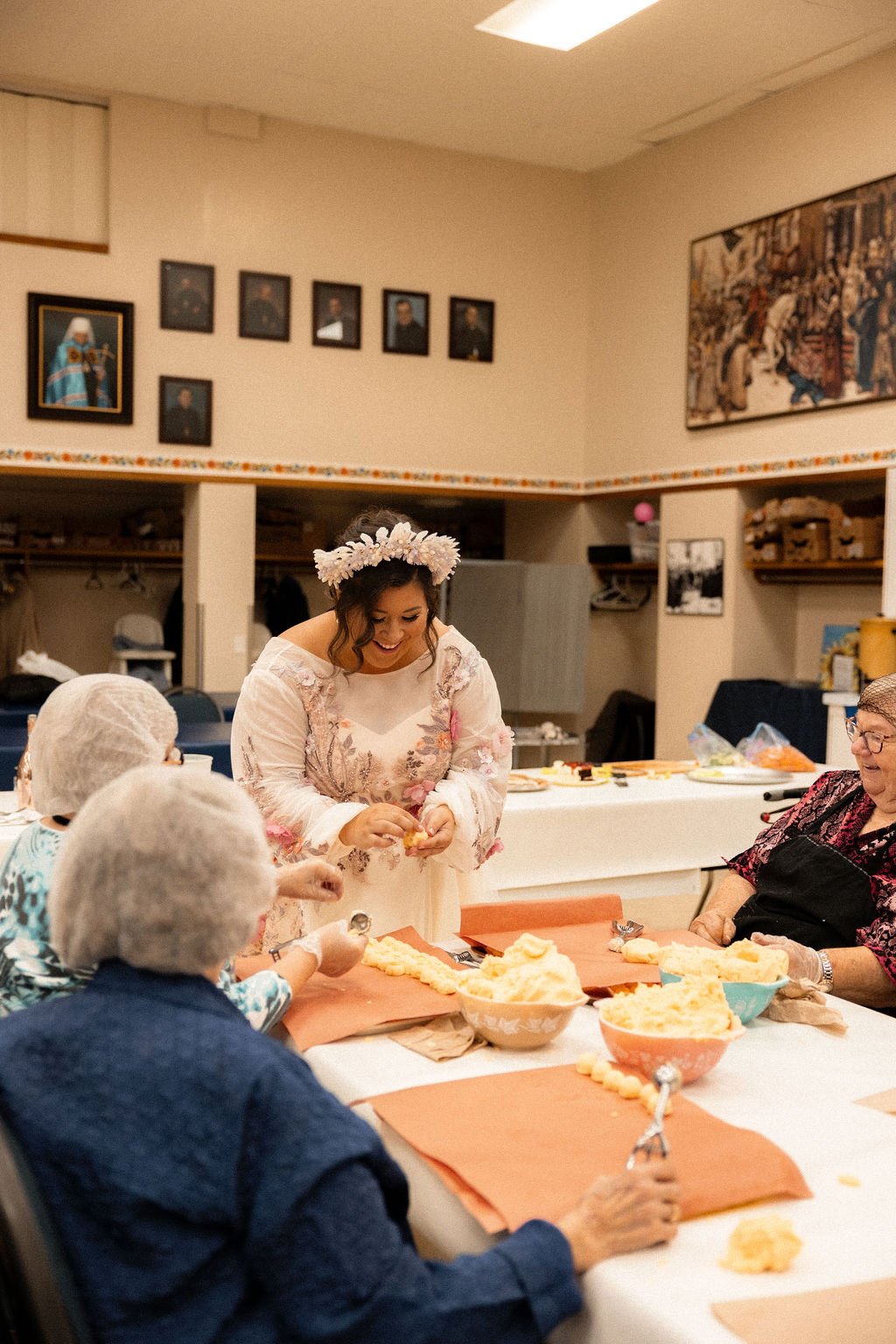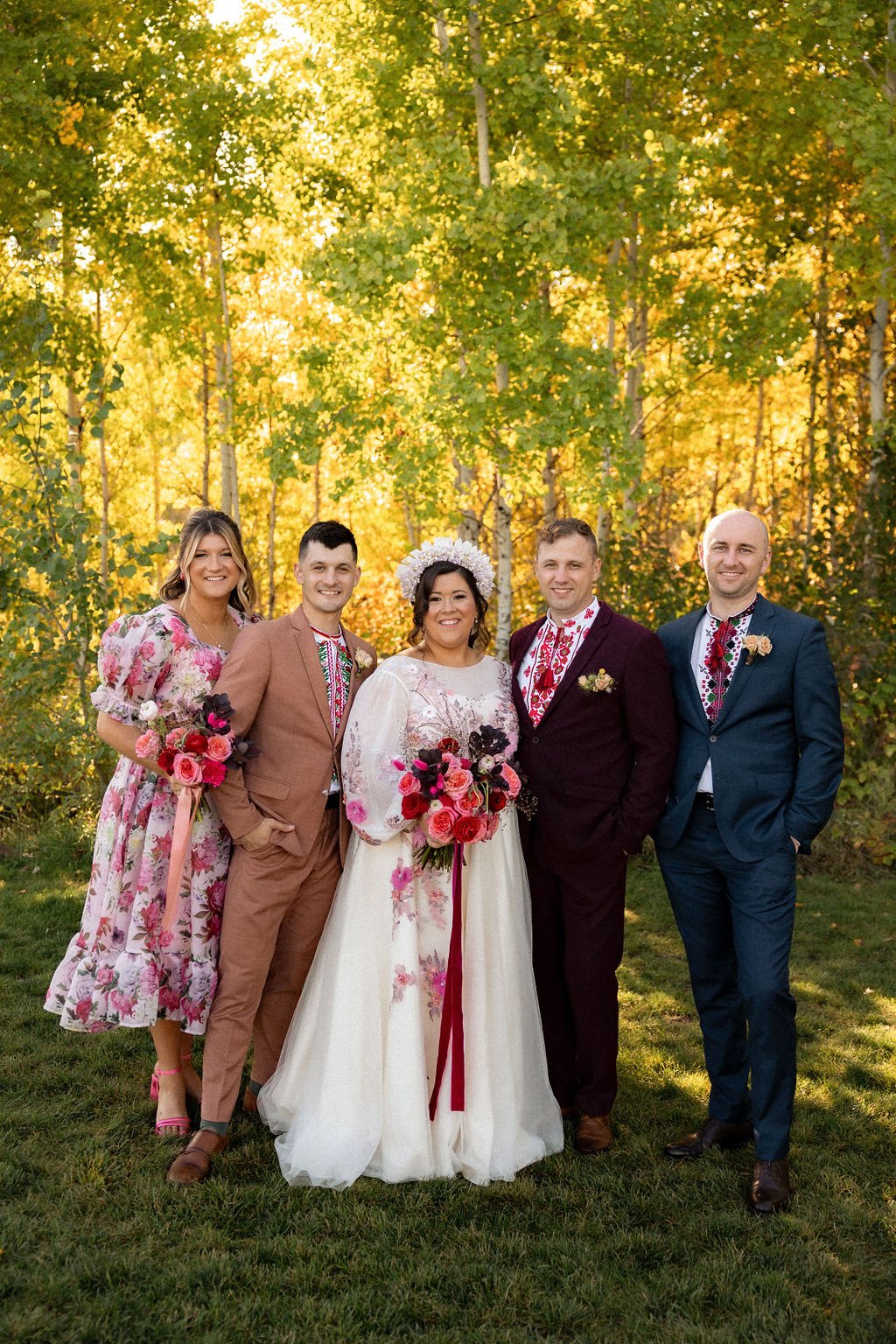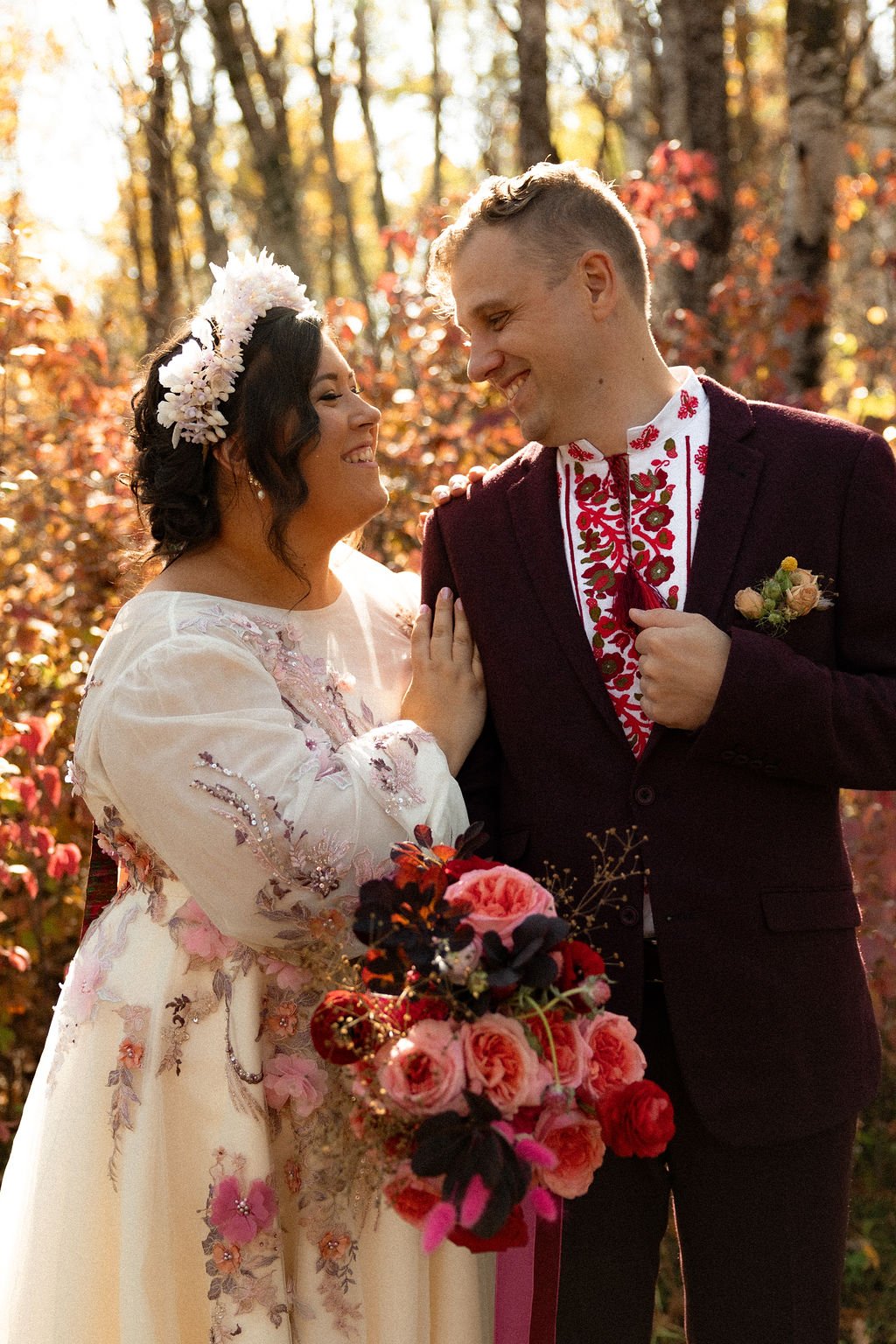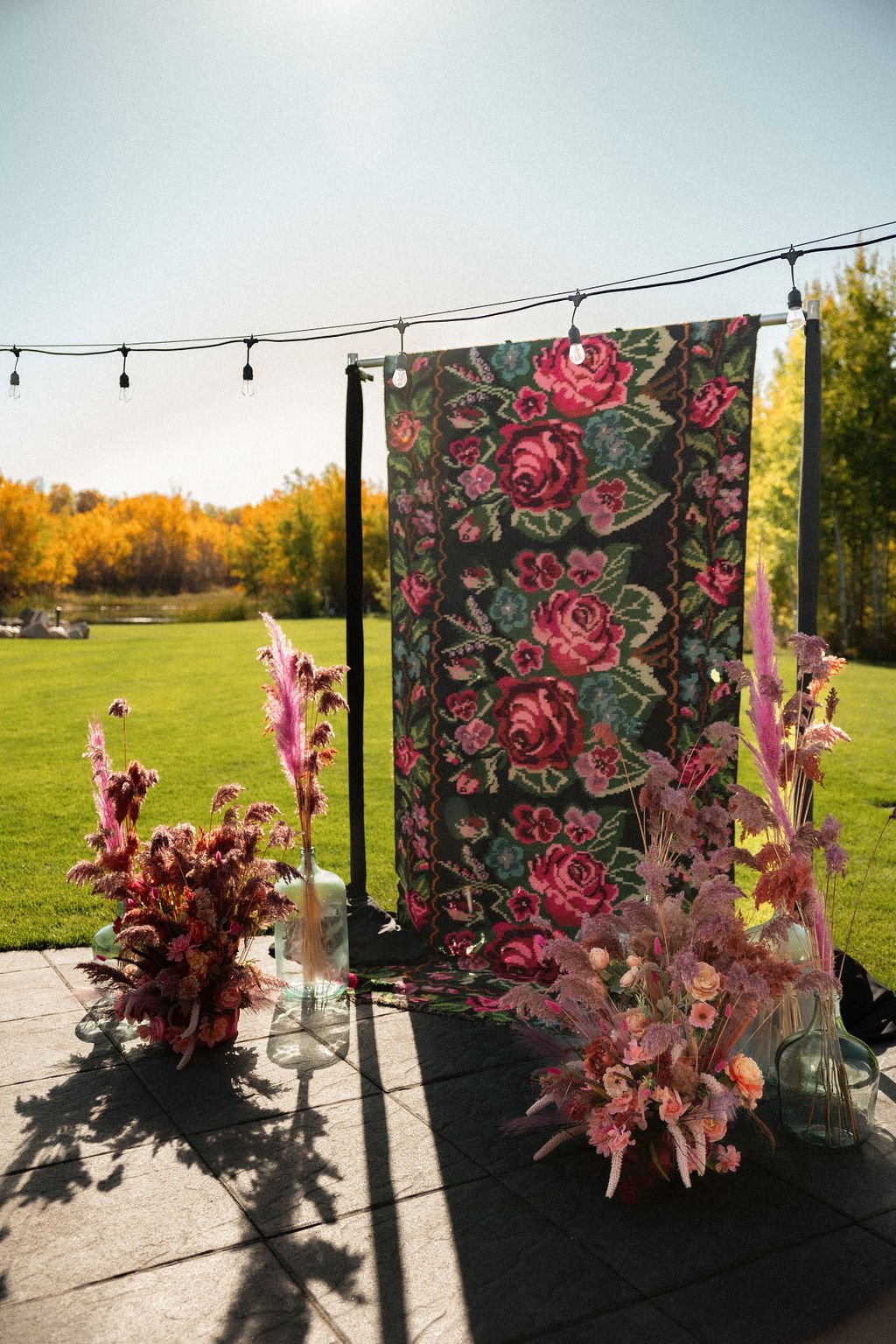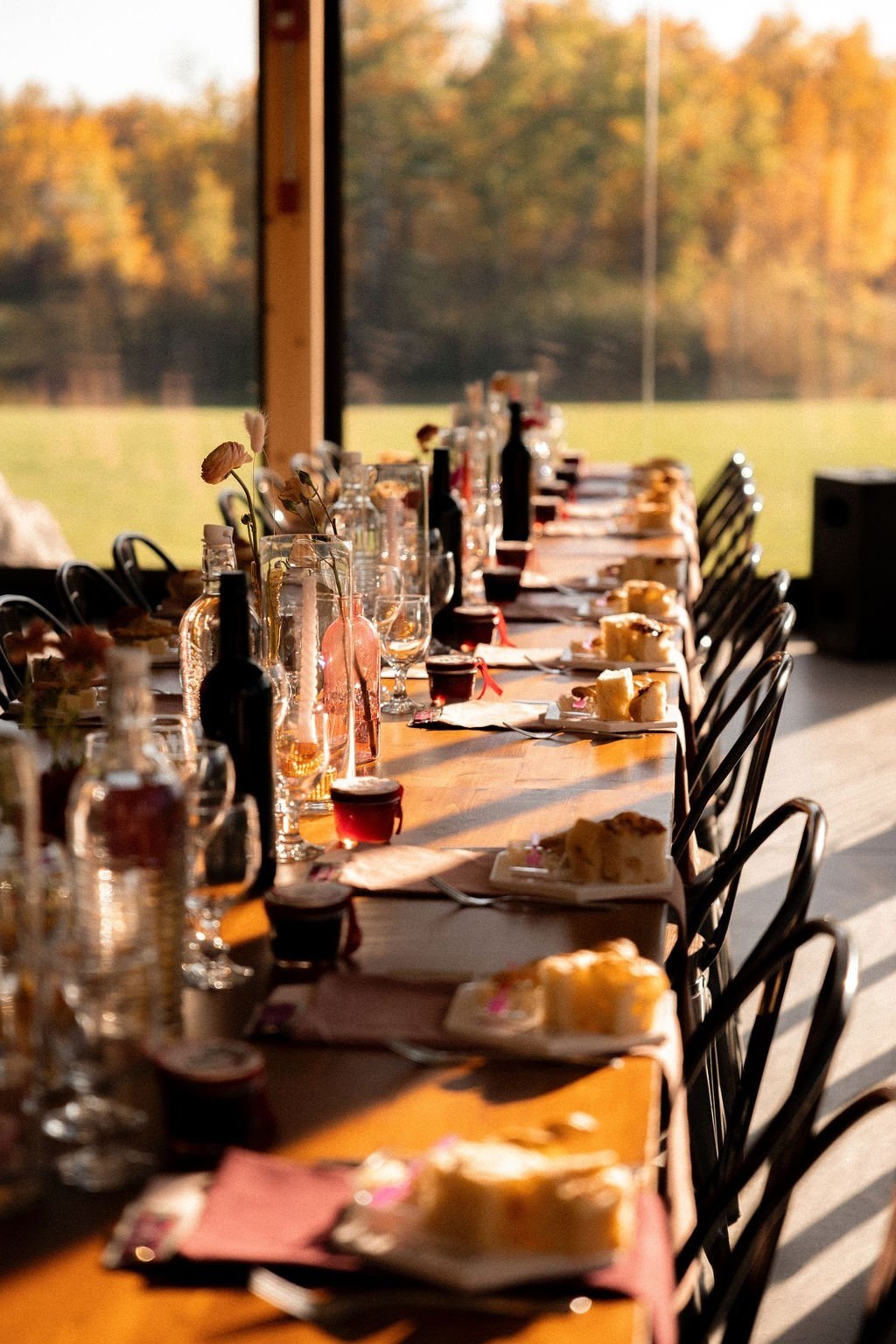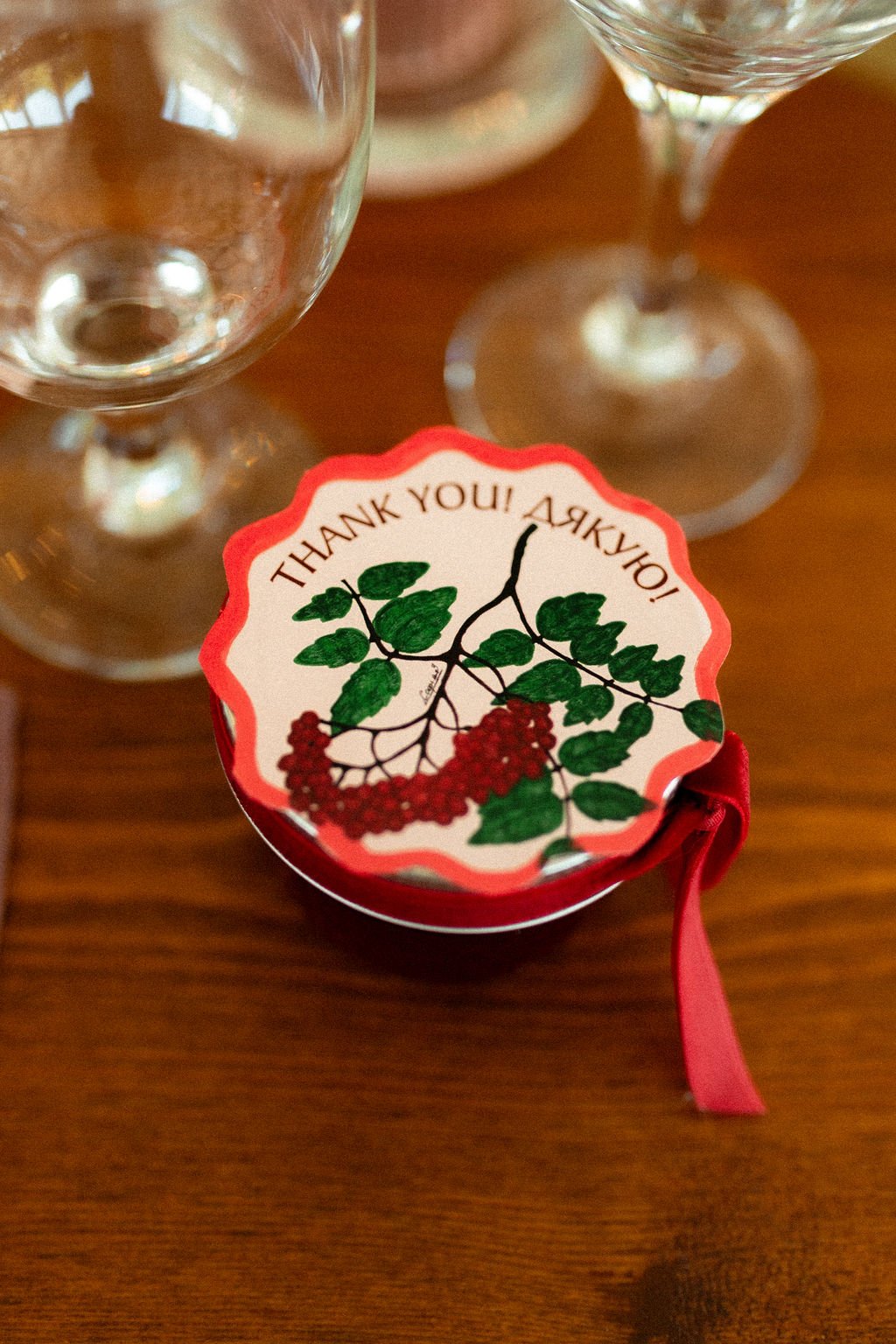Ukrainian wedding traditions
Mnohaya lita — wishing the couple many years of a beautiful life together. Wedding photos by Karina Walker.
On a beautiful Manitoba fall day, our little Hanny got married to the Ukrainian man of her dreams, Yulian.
Hannah’s cultural background has Ukrainian roots, and Yulian is from Ukraine, so it was important to them to incorporate traditions into their big day. Hannah and Yulian incorporated many Ukrainian traditions into their celebration, and we wanted to share them with you!
“We weren't just doing [the traditions] just to do them — that wasn't the point to me. It was to do them because there's meaning behind them, and they mean something to us,” Hannah says. “We didn't do them perhaps the traditional way that you would read in a textbook — we changed them to make sure that they reflected who we are.”
Even from village to village or family to family in Ukraine, the customs can vary, same with depending on the time period. While we’re going to outline some of the traditions Hannah and Yulian included, this isn’t a definitive, step-by-step guide. Rather, this is an overview of how these two newlyweds celebrated their wedding and incorporated Ukrainian traditions in their own way.
To hear even more about their wedding, listen to Episode 20 of Vsi.
And thank you to wedding photographer Karina Walker for capturing Hannah and Yulian’s day so beautifully!
The Matchmakers
The customs started before Hannah and Yulian even knew it.
Traditionally, respected elders in a village or city have the task of marrying off the kids in the community, basically arranging marriages.
The starosty (matchmakers) would usually present a man to a woman. If she rejected her suitor, she gave him a pumpkin, and if she accepted him, she sometimes would give him a pysanka. Once engaged, she’d tie a kerchief around his arm to show that’s who her mate is. The starosty would also have rushnyky (embroidered towels) tied around them, as a job well done, and they would accompany the couple to all the customs of the wedding.
This isn’t exactly how Hannah and Yulian’s matchmaking happened, but they did have starosty of sorts.
The two met at Canada’s National Ukrainian Festival in Dauphin in 2018, the year Hannah moved back to Canada from Ukraine after living there a year to study Ukrainian dance, language, and culture, and after handing out many, many pumpkins.
Hannah and Yulian had a couple mutual friends, Valerii and Andrii, who introduced the two in Dauphin. And that was that. They spent a lot of time together at the festival, decided to pursue it further once back in Winnipeg, and five years later, they got married.
Vinkoplettenya
A night or two before the wedding (or a few days before, in Hannah’s case), vinkoplettenya takes place. Girls and happily married women gather to weave wreaths, or vinky, for the couple to wear at their wedding ceremony. The women also weave a garland to go around the korovai, the wedding bread. The weavers use barvinok (periwinkle) and myrt (myrtle), plants that symbolize everlasting love. As they weave, the women sing songs (at Hannah’s, Ukrainian music played in the background).
A few days before Hannah and Yulian’s wedding, their family gathered for vinkoplettenya to weave vinky for them to wear during their wedding ceremony.
Many of Hannah’s relatives as well as Yulian attended her vinkoplettenya — it wasn’t just for the women. Her mom sprinkled the greenery with nuts so the couple’s future is strong, candy so their future is sweet, coins so they will be rich, and wheat so they will be happy. Hannah’s Baba blessed the plants with holy water, and then all the ladies started weaving.
As you weave, you should have a clear mind and set good intentions for the couple — you’re weaving in good fate into the wreaths for the couple. Some people add things into the wreath for good luck, like garlic to ward away bad spirits and coins to attract riches. If you’re using thread to secure the greenery, avoid tying knots, which could cause a knot in the relationship.
You should avoid using yellow or brown leaves in the wreaths, since it could be a bad omen for the couple. And if you pick your own myrtle or periwinkle, be sure to not harvest it from the same patch you picked branches for a funeral, which would also be a bad omen for the couple.
Hannah wore her hair braided that night, and at one point in the evening, she took out her braid, and people took turns brushing her hair, a way to say goodbye to her girlhood. Often, the bride’s parents, grandparents, and godparents brush her hair, but many other of Hannah’s guests that evening took their turn. While traditionally this may have been more of a solemn part of the evening, marking such a big transition, this was a lighthearted part of Hannah’s evening, with everyone laughing as they brushed her hair.
Once she had silky smooth hair, Hannah’s sister rebraided her hair, adding coins into it to wish riches onto the couple.
Wedding Tree
Yulian and Hannah went into the bush beside her parents’ house and dug up a small spruce tree that would serve as their derevtse or hiltse, the wedding tree. Sometimes people just cut them down for the wedding, but Hannah and Yulian wanted to dig it up so they could put it in a pot and plant it after their wedding.
Hannah brought the tree to a dance rehearsal of Selo Ukrainian Dancers, the school she and her parents run. While Ukrainian music played in the background, each dance group helped decorate the tree by tying ribbons on it.
A wedding tree is supposed to bring happiness to the couple and protect them from evil. After the wedding, the newlyweds put the tree somewhere in their yard. The tree weathers the storm, symbolizing any challenges that the couple will have to work through together.
Korovai
Happily married women typically bake the korovai, the wedding bread which symbolizes the unity of two families and how two hearts are becoming one. The bread is usually braided and decorated with dough doves, roses, leaves, and other ornaments. Like when weaving the vinky, it’s important to have good intentions in mind while making the bread.
Hannah actually baked her korovai herself, which was a nice way for her to reflect on her upcoming wedding day and how so many of her loved ones would gather to celebrate her and Yulian’s love. With her Baba, Hannah made 160 dough doves that adorned her korovai. Each bird represented one of the guests at the wedding.
Hannah baked the couple’s korovai and decorated it with dough doves she made with her Baba. And check out those beautiful bouquets — Kaitlin’s sister Rayna (Prairie and Yard Floral Design) did the wedding flowers!
Ransom (?!?)
There’s an old custom where the groom would pay a ransom to the bride’s father or brother, which isn’t something that exactly aligns with Hannah and Yulian’s values and beliefs.
In a way to pay tribute to traditions in general, Yulian found a more playful — and respectful — way to “pay a ransom.” When Yulian arrived at Hannah’s parents’ home on the wedding day for Hannah and Yulian’s first look, he presented her mom with a rose and her dad with a toy horse. And all of this was a surprise to Hannah too!
Yulian explained that there’s a saying in Ukrainian that a mother raises her daughter to be as beautiful as a rose. Yulian said while no rose could ever be as beautiful as Hannah, he hoped the rose he presented her mother would bring beauty into the home now that Hannah would no longer be there.
When giving the stuffed horse to Hannah’s dad, Yulian said that he wanted to add another living being to their property so there would be the same number of beings as when Hannah was there. The stuffed horse, which is a replica of the horse from the movie Spirit, Hannah’s dad’s favourite movie, represents the horse that Yulian plans to buy for her dad.
Blessing from the Parents
After Yulian presented the gifts to her parents (and after everyone wiped their tears), Hannah’s parents and Yulian’s mother gave a blessing (blahoslovennya) to the couple. Hannah and Yulian knelt on a rushnyk and the parents gave a blessing to wish the couple happiness and prosperity as two families became one. The parents then held the kolach over the couple’s heads and made the sign of the cross with the kolach, then Hannah and Yulian kissed the bread. Hannah then hugged Yulian’s mom, and Yulian hugged Hannah’s parents.
Even though Hannah’s parents received a blessing on their wedding day, they weren’t certain what to include in the blessing. But Hannah reassured them that the meaning isn’t from following an exact script — the meaning comes from their hearts. The same can be said about any of these traditions; what’s important is doing what feels right and meaningful to you, even if it’s not the exact same way as the original custom.
As a “ransom,” Yulian presented Hannah’s parents with a rose and a toy horse on the morning of the wedding.
During the parents’ blessing on the morning of the wedding, they made a sign of the cross with a kolach over the couple’s heads.
The Wedding Ceremony
Hannah and Yulian got married in an Orthodox church. As if Hannah’s day couldn’t get any better, when she went into the church basement, there happened to be people making varenyky, and Hannah even got to pinch a perogy! Maybe this should be a new tradition — you seal a happy wedded life with every pinch.
There are many traditions you can include during the ceremony, depending on the church, the priest, and what you want. Here are a few highlights from Hannah and Yulian’s wedding:
Hannah and Yulian got engaged at the back of the church before walking down the aisle. (They’ve been engaged for a couple years but this marks their official engagement in the eyes of the church.)
Hannah and Yulian walked down the aisle together, rather than walking with their parents. This symbolizes they are walking into the church as equals and are on this journey of life together as equals.
They didn’t exchange vows during the service — that they walked into the church together shows their vows to one another.
During the exchange of rings, the bride’s ring is put on the groom, and vice versa. The priest then switches them back and forth three times, then the bride and groom end up wearing their own ring. This symbolizes how their lives will be intertwined forever.
The priest crowned them with the wreaths family weaved during vinkoplettenya. At this point, Hannah and Yulian become the king and queen of their own kingdom. They also stepped onto a rushnyk on the ground. It’s said if someone steps on it first, they become the head of the household, but like many other couples, Hannah and Yulian chose to step on the rushnyk at the same time.
The priest tied Hannah and Yulian’s right hands together, symbolizing that they’re going to be tied together forever. They then walked around the altar three times, taking their first steps as husband and wife.
Once they were married, they walked out of the church, greeted by all their guests. Hannah and Yulian held a kolach with a hole in it and looked through it into the sky, to see what their future might hold. There weren’t many clouds, so they didn’t get any hints of their future based on the clouds’ shapes, but perhaps a clear, sunny day simply means there are sunny days ahead for the couple.
After looking through the kolach, Hannah and Yulian had a bit of a tug-of-war with the bread — whoever gets the bigger piece is said to be the head of the household. Yulian got the bigger piece in this case! (Though onlookers say he looked pretty concerned by such a thing, looking like he wanted to switch halves with Hannah.)
Instead of blowing bubbles at the couple, guests waved tiny little vinky Hannah’s mom made out of wooden rings and ribbons.
Other fun things
If we wrote every single Ukrainian detail in detail from Hannah and Yulian’s wedding, the internet would run out of space. Here are a few other quick notes worth mentioning (though it was all worth mentioning — check out all the photos and zoom in on every item to truly immerse yourself!):
Wedding dress: Through Etsy, Hannah found a Ukrainian seamstress, who is currently living outside of Ukraine.
Wedding vinok: Made in Ukraine, a replica of a traditional wax wedding wreath from the Vinnytsia region.
Men’s vyshyvanky: Hannah’s best man, Hannah’s man of honour, and Hannah’s dad wore vyshyvanky that featured embroidery representative of the region of Ukraine they are from or their family is from. Postmark Ukraine made the embroidered shirts.
Wedding favours: Hannah’s Baba, Dido, and mother picked kalyna (high bush cranberry), and Hannah and her Baba made jam out of them to gift to the guests. Yulian’s daughter painted a kalyna bush on all the tags.
Wedding rushnyk: Hannah and Yulian’s rushnyk they got for their wedding is a replica of a traditional design from Poltava, a city Hannah lived in for two months in 2018, and features a tree of life, representing the past, present, and future.
Table “numbers”: Instead of table numbers, Hannah and Yulian labelled tables with Ukrainian motifs for guests to find their seats. Each motif had a blessing to go along with it and was specific to the people at the table. For example, Hannah’s friends from Troyanda Ukrainian Dance Ensemble had a rose motif, since troyanda means rose in Ukrainian. They were offered the following blessing: May your journey be overflowing with moments of love and the extraordinary beauty found in everyday moments. Here's to a life filled with deep connections that bring joy to your soul.”
Having these motifs, resembling Ukrainian embroidery, was Hannah’s way of embroidering something for all her guests. Traditionally, the bride embroiders all the items for wedding, something she starts as a young girl. Throughout her life, she adds the embroidered pieces to her skrynya (hope chest).
Covering of the bride: This is one of the last traditions of the wedding night. For this, sometimes the bride sits on a white pillow or her husband’s lap. Her mother (or mother-in-law or godmother) unbraids the bride’s hair and brushes it for the last time. Hannah had many, many pins in her hair, so her mom didn’t take out her hair. Instead, Hannah’s mom removed Hannah’s white vinok she was wearing and covered her hair with a white kerchief.
Passing along the bride’s married fate: As Hannah’s friend Nina sang “Horila Sosna,” the unmarried girls at the wedding formed a circle around Hannah. Hannah then chose one girl at a time to dance with and held her vinok above their head, passing along her married fate. The girls who dance with the bride would also get a ribbon from the bride’s vinok that the girl will add to her vinok for her wedding day. To represent this, at all the guests’ place settings, a piece of the same ribbon as in Hannah’s vinok was attached to everyone’s name tags.
Other fun things: They had a LED sign that said Mnohaya Lita (“wishing you many years of life”), appetizers served on tiles that said Smachnoho (“enjoy your food”), signature drinks like the Sumy Slammer made with cherry juice from a local Euro store, and a kylym (carpet) as a photo-op backdrop. Also, instead of clinking glasses or the like to make the couple kiss during the reception, guests had to chant “Hirko,” a tradition in Ukraine. “Hirko” means bitter. And how do you counteract something bitter? With something sweet!
To hear more details about Hannah and Yulian’s wedding, listen to Episode 20 of Vsi. And remember, this is more of a guide, not a set of rules — incorporate traditions in a way that feels right to you!
Yulian is from Sumy, where many of his friends and family live today. His mother was able to attend the wedding, but many of those close to Hannah and Yulian weren’t able to make it, including Yulian’s father and daughter. Those who couldn’t be there in person were still felt in spirit — they were there in every detail throughout the day. And Hannah and Yulian can’t wait to celebrate with them in Ukraine after Ukraine’s victory.









